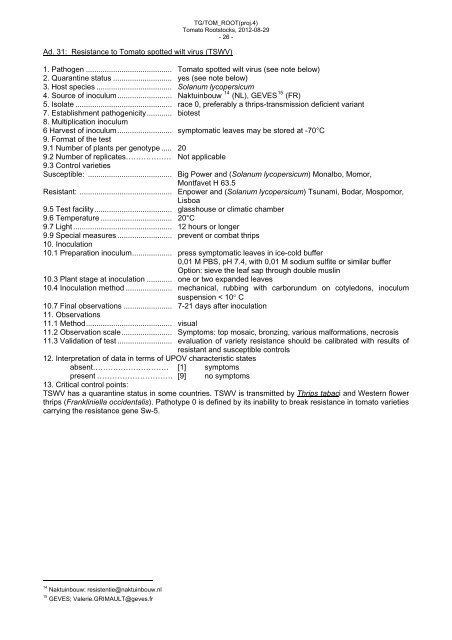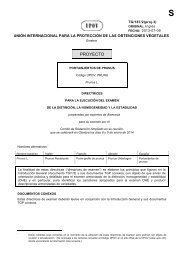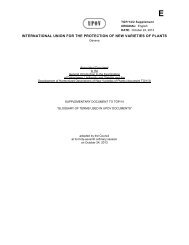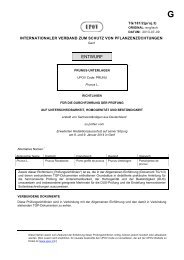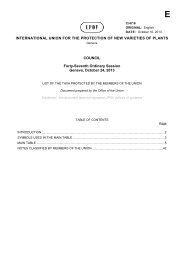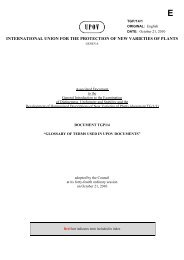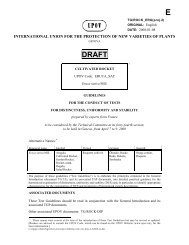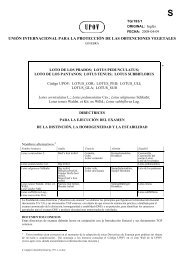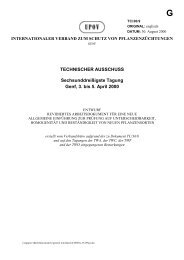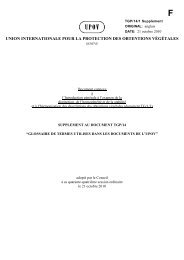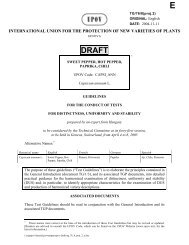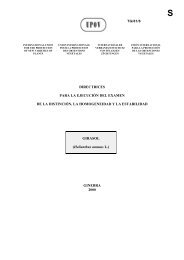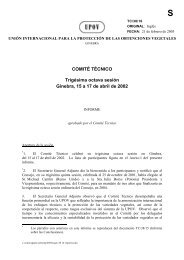E - International Union for the Protection of New Varieties of Plants
E - International Union for the Protection of New Varieties of Plants
E - International Union for the Protection of New Varieties of Plants
Create successful ePaper yourself
Turn your PDF publications into a flip-book with our unique Google optimized e-Paper software.
TG/TOM_ROOT(proj.4)<br />
Tomato Rootstocks, 2012-08-29<br />
- 26 -<br />
Ad. 31: Resistance to Tomato spotted wilt virus (TSWV)<br />
1. Pathogen ......................................... Tomato spotted wilt virus (see note below)<br />
2. Quarantine status ............................ yes (see note below)<br />
3. Host species .................................... Solanum lycopersicum<br />
4. Source <strong>of</strong> inoculum.......................... Naktuinbouw 14 (NL), GEVES 15 (FR)<br />
5. Isolate .............................................. race 0, preferably a thrips-transmission deficient variant<br />
7. Establishment pathogenicity............ biotest<br />
8. Multiplication inoculum<br />
6 Harvest <strong>of</strong> inoculum.......................... symptomatic leaves may be stored at -70°C<br />
9. Format <strong>of</strong> <strong>the</strong> test<br />
9.1 Number <strong>of</strong> plants per genotype ..... 20<br />
9.2 Number <strong>of</strong> replicates……………… Not applicable<br />
9.3 Control varieties<br />
Susceptible: ........................................ Big Power and (Solanum lycopersicum) Monalbo, Momor,<br />
Montfavet H 63.5<br />
Resistant: ............................................ Enpower and (Solanum lycopersicum) Tsunami, Bodar, Mospomor,<br />
Lisboa<br />
9.5 Test facility..................................... glasshouse or climatic chamber<br />
9.6 Temperature .................................. 20°C<br />
9.7 Light ............................................... 12 hours or longer<br />
9.9 Special measures .......................... prevent or combat thrips<br />
10. Inoculation<br />
10.1 Preparation inoculum................... press symptomatic leaves in ice-cold buffer<br />
0,01 M PBS, pH 7.4, with 0,01 M sodium sulfite or similar buffer<br />
Option: sieve <strong>the</strong> leaf sap through double muslin<br />
10.3 Plant stage at inoculation ............ one or two expanded leaves<br />
10.4 Inoculation method ...................... mechanical, rubbing with carborundum on cotyledons, inoculum<br />
suspension < 10� C<br />
10.7 Final observations ....................... 7-21 days after inoculation<br />
11. Observations<br />
11.1 Method......................................... visual<br />
11.2 Observation scale........................ Symptoms: top mosaic, bronzing, various mal<strong>for</strong>mations, necrosis<br />
11.3 Validation <strong>of</strong> test .......................... evaluation <strong>of</strong> variety resistance should be calibrated with results <strong>of</strong><br />
resistant and susceptible controls<br />
12. Interpretation <strong>of</strong> data in terms <strong>of</strong> UPOV characteristic states<br />
absent………………………… [1] symptoms<br />
present ………………………… [9] no symptoms<br />
13. Critical control points:<br />
TSWV has a quarantine status in some countries. TSWV is transmitted by Thrips tabaci and Western flower<br />
thrips (Frankliniella occidentalis). Pathotype 0 is defined by its inability to break resistance in tomato varieties<br />
carrying <strong>the</strong> resistance gene Sw-5.<br />
14 Naktuinbouw: resistentie@naktuinbouw.nl<br />
15 GEVES; Valerie.GRIMAULT@geves.fr


